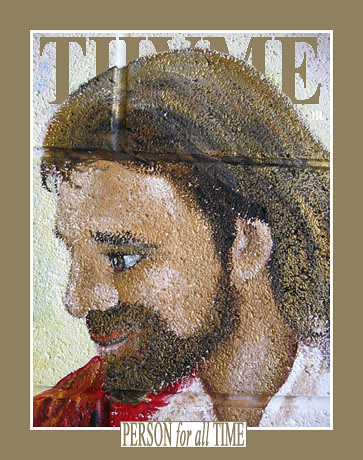
Volume II, Issue LIV
A Person for All Time
Since 1927, TIME Magazine has chosen a man, woman, or idea that for better or worse, has most influenced events in the preceding year. Charles Linbergh was the first person to be so honored.
In 1938 Adolph Hitler was named. FDR received the honor three times. Osama Bin Laden was considered for recognition early in this decade.
TIME declared Albert Einstein the most influential person of the century. I don't believe they have ever tried to name the most influential person in all of human history.
THYME Magazine, looking back on thousands of years of history, breaks with the modern trend to honor media creators and celebrities. Gutenberg, in our minds, is far more of an innovator than Zuckerberg.
When Samuel Morse invented the telegraph, he sent the first 'Instant Message:' "What hath G-d Wrought?" Morse was on to something. There is always a back story of inspiration in every innovation.
So THYME today wants to single out inspiration. Our choice for 'Person for All Time' will no doubt place us in controversial territory. Still,we invite you to examine history for yourself. Alvin Schmidt's "Under the Infuence" [click to read] could be considered your essential guide as you meet THYME's 'Person for All Time.'
One Solitary Life
"Here is a man who was born in an obscure village, the child of a peasant woman. He grew up in another village. He worked in a carpenter shop until He was thirty. Then for three years He was an itinerant preacher.
He never owned a home. He never wrote a book. He never held an office.He never had a family. He never went to college. He never put His foot inside a big city. He never traveled two hundred miles from the place He was born. He never did one of the things that usually accompany greatness. He had no credentials but Himself...
While still a young man, the tide of popular opinion turned against him. His friends ran away. One of them denied Him. He was turned over to His enemies. He went through the mockery of a trial. He was nailed upon a cross between two thieves. While He was dying His executioners gambled for the only piece of property He had on earth – His coat. When He was dead, He was laid in a borrowed grave through the pity of a friend.
Nineteen long centuries have come and gone, and today He is a centerpiece of the human race and leader of the column of progress.
I am far within the mark when I say that all the armies that ever marched, all the navies that were ever built; all the parliaments that ever sat and all the kings that ever reigned, put together, have not affected the life of man upon this earth as powerfully as has that one solitary life."
This widely distributed essay was origially adapted from a sermon by Dr James Allan Francis in “The Real Jesus and Other Sermons” © 1926 bythe Judson Press of Philadelphia (pp 123-124 titled “Arise Sir Knight!”).
He never set foot in Rome, the seat of Empire, yet Alvin Schmidt and others have documented how this simple man from Galilee changed the human epic.
For many it was the 'righteous gentiles'... Christians who risked their own lives and safety to hide their Jewish neighbors and sneak them out of Nazi occupied parts of Europe. For the mentally ill it was Dorothea Dix, a Christian woman who worked to provide more humane treatment.
Christianity is often blamed for many of the world's ills when in fact you can look to it in its pure form and see the exact opposite. Yes, much evil has been done by men who claim to do it 'in the name of G-d,' but look at the lives of those who actually dare to live by Christ's teaching and you will see a clear departure from culture's corruption.
William Wilberforce and John Newton are prime examples of this. Newton was a slaver. When he came to faith he was repulsed by his involvement in this trade in human misery. When his friend Wilberforce, a rising member of the British government, came to faith, he was going to step away from government to devote his life to G-d. Newton urged Wilberforce to remain in public service and his legacy became the end of slavery in every land under British rule.
Cover Art: Detail of a mural by L. Riley and B. Kirchman




No comments:
Post a Comment